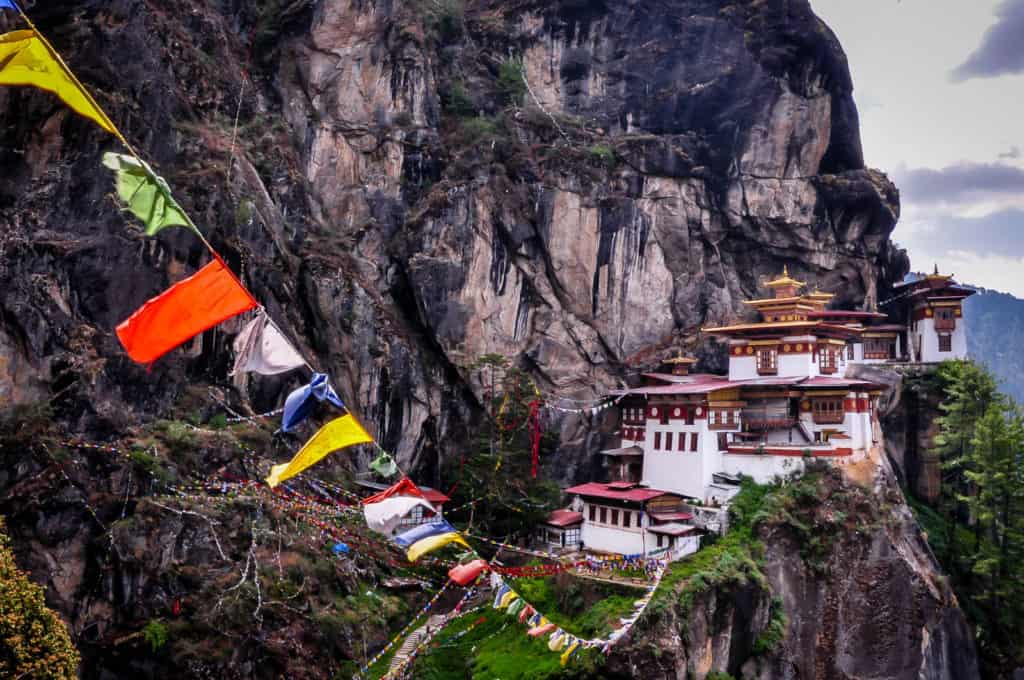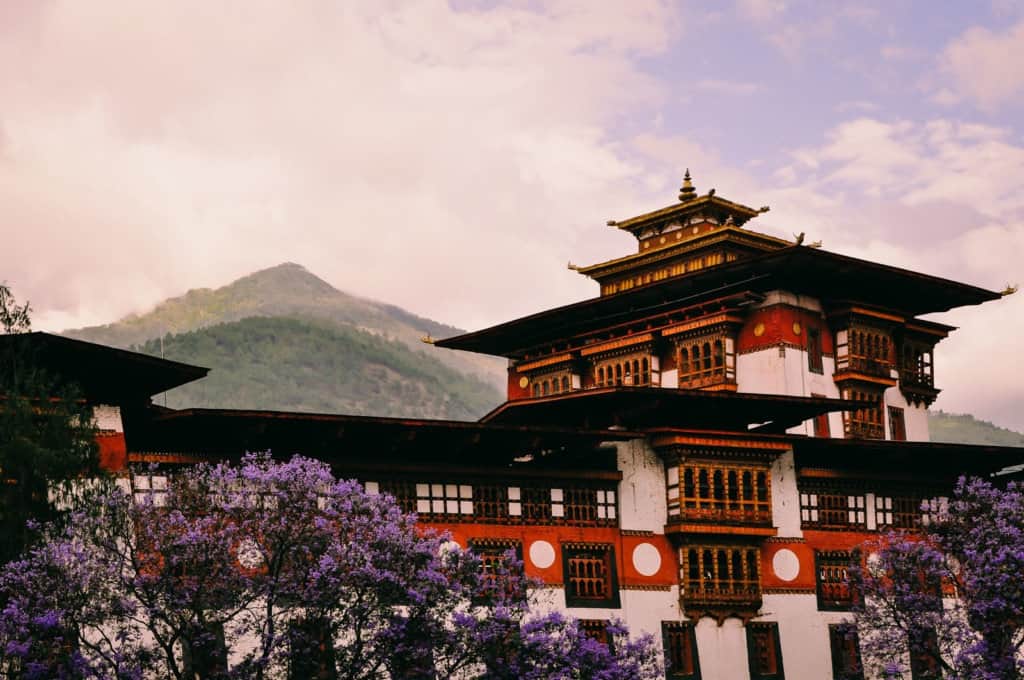Travel Guide | Bhutan
Welcome to the Kingdom of the Thunder Dragon
Text | Anninka Kraus
Photography | Tobias Kraus

Bhutan
We had just completed a hike through the Annapurna Mountains in central Nepal and were excited for our next stop – Bhutan!
When I learned that Bhutan was also referred to as Kingdom of the Thunder Dragon, I thought it sounded mysterious and promising enough to endure the flight from Kathmandu to Paro, which Dawa, our porter guide through the Annapurna circuit had referred to as one bumpy rollercoaster hell of a ride.
I was reminded of his joke “A little bit up, a little big down … it’s all flat in Nepali” when my knuckles turned white from gripping onto the armrests through the turbulence. But it was a mere 45 minutes before the air hostess, dressed in colourful traditional garb, asked us to fold our tray tables in preparation for landing.
Entry into Bhutan is only granted with visa clearance prior to arrival and the number of visas is strictly limited in accordance with the country’s High Value, Low Impact Tourism policy. These strict regulations were put in place to preserve the country’s unique environment and character and prevent mass tourism. I thought that low impact tourism sounded wonderfully advanced until our travel agent in an email elaborated on the bearing of high value.
Fortunately, by the time Tobi read out aloud said email and stumbled across a daily fee of US$250 per day, we had already set our mind on climbing up to the Tiger’s Nest – a temple clinging to a sheer rock face and Bhutan’s most iconic site.
We faltered slightly when we realised that US$250 was the daily fee for one person, not two, but booked six days nonetheless, counting on all other countries in Asia that we would visit to be significantly cheaper.
The airport terminal was built in traditional Bhutanese architecture with a triple-tiered green roof, elaborately painted wooden frames, and small narrow windows. It looked more like a temple and bore absolutely no resemblance to frenzied mega hubs like London Heathrow or Frankfurt. There was only one aircraft parked on the runway, ours, but then again Druk Air only owns three aircrafts and one prop plane and flies the route Kathmandu-Paro merely once a day. Outside the airport our obligatory tour escort, a guide and a driver, waited for us next to a new and clean minivan.
As we exited the airport grounds, driving towards Bhutan’s capital Thimphu at 2320m, we were immediately swamped with a deluge of information gushing out of Sante, our guide. He talked non-stop from Paro to Timphu and was a walking encyclopaedia on Bhutan. As interesting as his monologue was, we felt slightly overwhelmed by his urge to communicate all information at once and ask questions he would then answer himself right away.
He asked us to guess why all the cars on the road were in such excellent condition (which they weren’t) but without waiting for our answer proceeded to tell us it was the law, and that cars with so much as a scrape required immediate repairs by an officially approved garage. We did indeed marvel at the clean roadsides and learned that the government’s penalty for a little piece of paper carelessly thrown out of an open car window is a $35 fine, which is hardly affordable for most Bhutanese.
The topic of conversation then moved on to Bhutan’s highest peak, the Gangkhar Puensum at 7570m, which is also the world’s highest unclimbed mountain. Some expeditions failed at summit attempts in the 1980s most likely due to the reported extremely bad weather conditions, however no further mountaineering permits were issued since 1994 for religious reasons as, according to the Bhutanese, expeditions failed due to a horse deity on its peak that did not appreciate being disturbed.









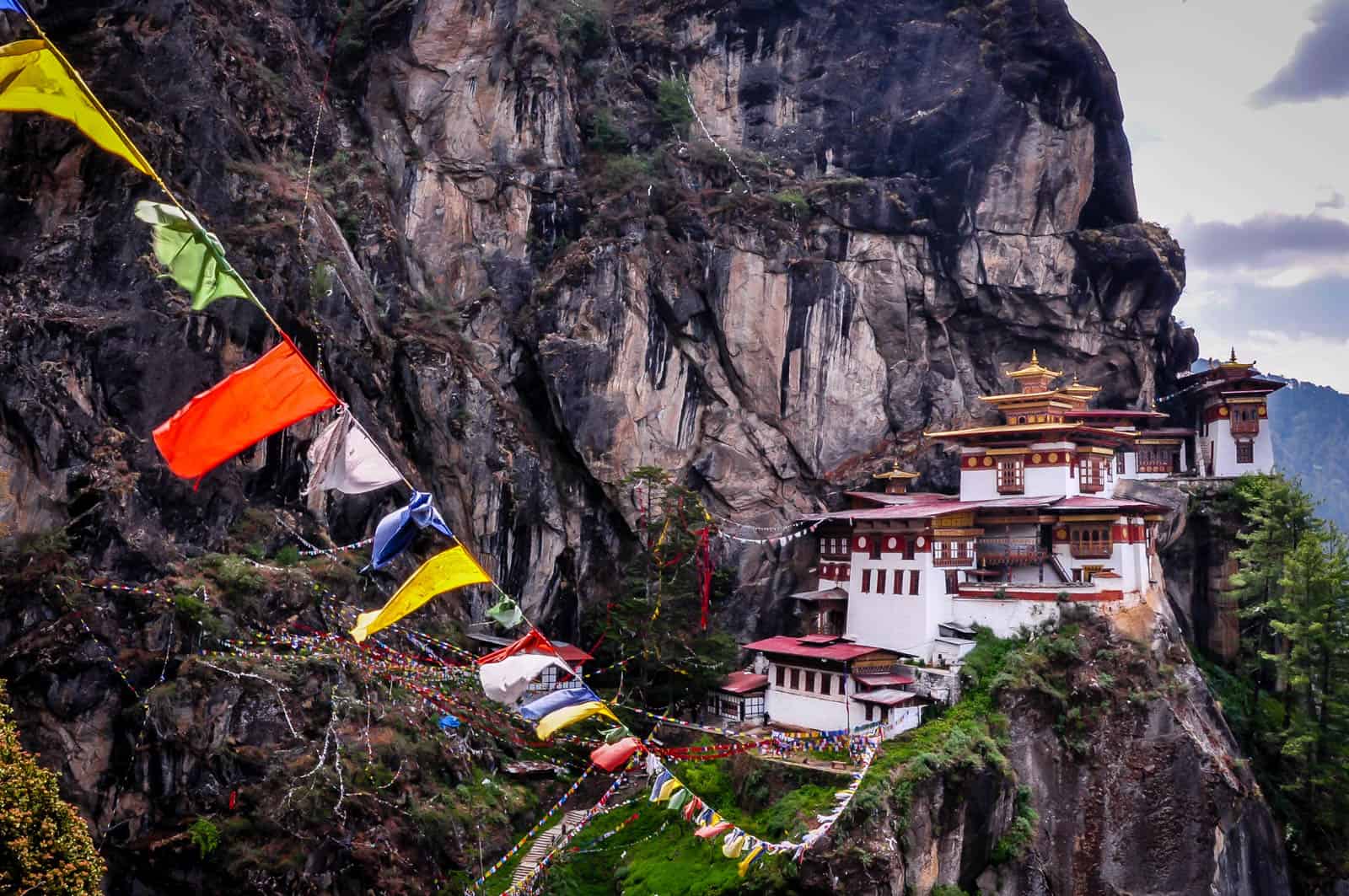
what to expect.
The Tiger’s Nest Monastery that was almost fully destroyed in a fire in 1998 but beautifully re-erected in its remote, unique location, huddled against the steep cliff face
The Punakha Dzong, a monastery beautifully positioned on an island at the confluence of the female river (Mo Chhu) and the male river (Pho Chhu) with lilac-blossoming jacaranda trees surrounding the fort in spring
Beautiful houses in original Bhutanese architecture with multi-coloured wood frontages
A country where religion and politics are also closely intertwined and economic success is measured in GNH (Gross National Happiness)
Bhutan was currently grappling with a heavy economic depression. Its constitutional monarchy, which was introduced as recently as 2008 and comes close to a Western democracy, stood on shaky ground as it faced the first elections since this form of government was introduced and the National Assembly elected in 2008.
Sante indeed believed the Government of Bhutan to be similar to Western democracies, and that may well be the case. In our eyes however, the strict control the constitutional monarchy exercises over foreign tourists but even more so over the Bhutanese people at times rather created an impression of a dictatorial regime or of the absolute monarchy that it once was. Many inhabitants, especially the elderly and farmers in remote rural areas, still had no idea what democracy even meant, Sante explained.
It would take decades to familiarize all citizens with their newly created rights and duties. At the moment though, all parties were electioneering like mad as in any democracy. I don’t know what campaigning entails in a country where the literacy rate reaches a mere 52.8% (percentage of persons aged 15 and over who can read and write; unicef 2008-2012), but on second thought, I hardly know of anybody back home who actually reads party manifests before an election (unlike the French who do, come il faut). At least the Germans cannot be accused of being easily swayed by a photo of a pretty face on a campaign flyer, not after 30 years of Helmut Kohl, Gerhard Schröder, and Angela Merkel as Federal Chancellors.
In Bhutan, it’s still obligatory to wear traditional dress to school and work. The men wear the gho and the women the kira. It looked nice, everybody dressing the same in woven garments that only differed in colour, but I very well remember wearing school uniform – a kilt, blouse, and blazer – and how eagerly we anticipated mufti day once a term. If someone back then had told me I’d wear that uniform for the rest of my life, I wouldn’t have been very happy about it at all.
We passed many beautiful houses in original Bhutanese architecture with multi-coloured wood frontages on the drive from Paro and Thimphu and my enthusiastic remark about it to Tobi prompted another torrent of words from Sante. He told us that no one is obliged to paint his or her home, but it is very much encouraged. I was somewhat sceptical when he put it down to a permanent competition among the Bhutanese of ‘Who’s got the most beautifully decorated home?’ – if you have to race to the garage to get scratches polished first thing after a car accident, how would the same principle not apply to a dove pooping down your home’s front facade?
In any case, these gorgeous homes embellished the landscape and made us curious about this people that so proudly and devotedly adhered to their unique culture. When we learned that a policy of ‘One Nation. One People’ had ruled the country since the late 80s and imposed a cultural assimilation duty on its citizens, this curiosity however swiftly faded to disillusionment. Tens of thousands of ethnic Nepali, the Lhotshampas, were stripped of their citizenship by discriminating citizenship laws and fled or were deported to refugee camps in Eastern Nepal in the 1990s. Many had been living in Bhutan for generations and knew no other home.
Ethnic cleansing doesn’t read well (especially when you’re German) and didn’t go well either for more than 100.000 people who lived in refugee camps by 2008 (UNHCR). I wondered how much Gross National Happiness plummeted when one-sixth of the population was denied their home and suffered from camp conditions rife with malnutrition and diseases.
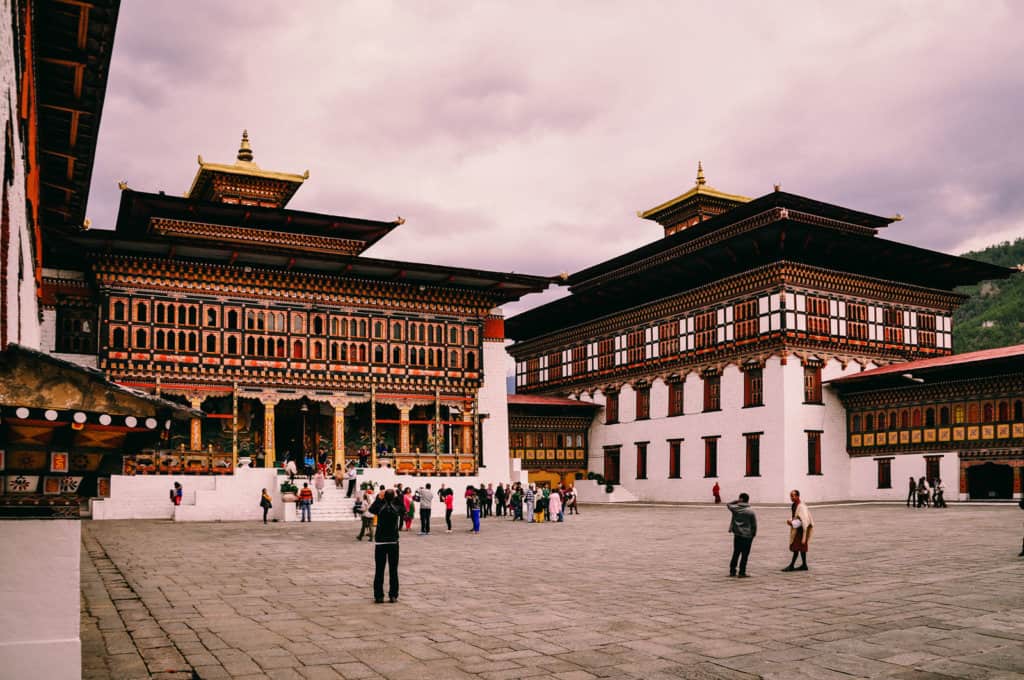
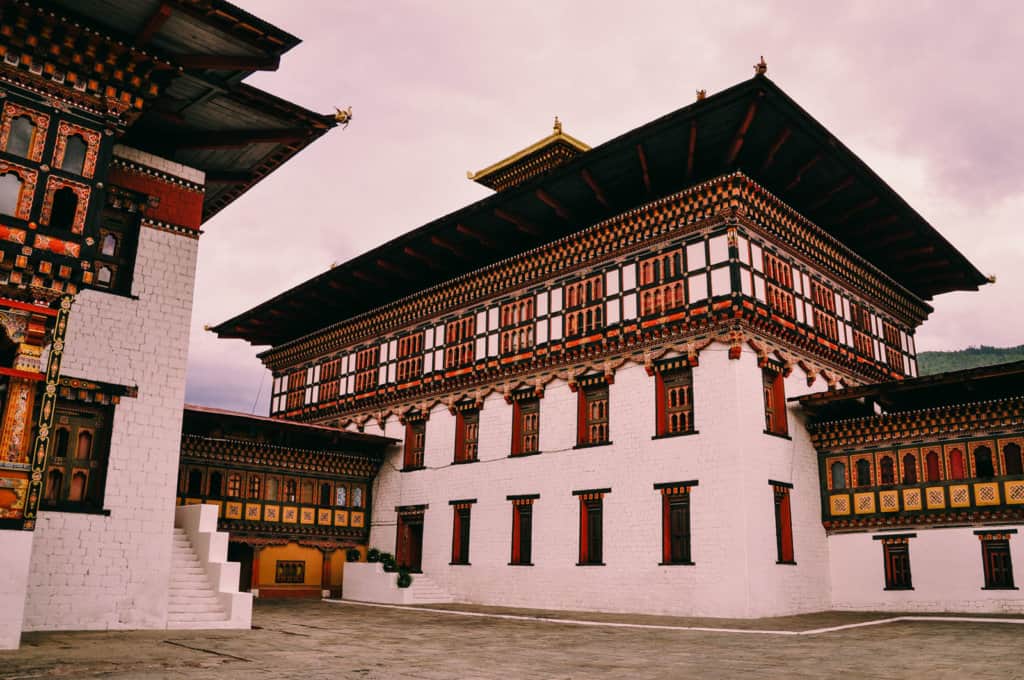
We spent a full day sightseeing in Thimphu and visited a stupa (a dome-shaped Buddhist shrine), several Bhutan takin in an outdoor pen (their national animal, which looked hilarious, like a clumsy cow with a giant head), a traditional Bhutanese house from inside, a school of arts teaching crafts (such as painting, carving, sculpturing and embroidery), a giant golden Buddha statue still in the making, and the Dzong of Thimphu.
Throughout the day Sante explained Buddhism to us, and the more we learned the greater the scope in which religion governed and influenced the daily life of this people appeared. According to Sante, two of four types of Buddhism are practised in Bhutan. Some of these have five Buddhas, some seven, and sometimes Buddhas were depicted as skulls (but from what I gathered, this didn’t imply that the Buddha was dead). Seventy percent of Bhutanese practise Mahayana Buddhism, which is not surprising as Bhutan is the only country worldwide where this is state religion. Sante’s vast knowledge caused me some information overload, but I got the impression that this religion is peaceful (as long as you’re not ethnic Nepali or a monk resigning from his vocation), time-consuming, rather complex, and also heavily based on a fear of demons, hell, and torments that follow on negative doings.
Sante talked of hundreds of deities in dozens of different reincarnations, countless books filled with religious text, rituals aplenty, the most complex and – to an ignorant outsider – incomprehensible philosophy, and decades of meditation that were necessary to come even remotely close to a stage called Enlightenment. As everybody seemed to strive towards this Enlightenment stage it must be disappointing, I thought, that only very few managed to get there while the remaining 100% of followers (after rounding the decimal places) lingered in an unfortunate intermediary stage as humans (personally I think that’s not too bad really) or ended up in hell (which definitely sounds less desirable). We learned that some monks meditate for decades without eating and metamorphose into grazing animals to still their hunger. I assumed it was a story with symbolic meaning rather than actually believed to be a true fact.
Religion and politics are also closely intertwined. The coronation ceremony of the new king for example was moved from 2006 to 2008 because 2006 was a bad year to hold such ceremonies according to their spiritual leader. Imagine the joy of a democratic government in office that is told that the next elections would have to be postponed for another two years because of atmospheric disturbances. Also, parents need not suffer through the bothersome process of picking their child’s name. A priest will do that for them after consulting the astrological calendar. So, at the age of three you’re a Buddhist, and you better not chance a fling with another religion because according to Sante that’s a serious slip and punished with hell. On the other hand, Buddhists are very accepting of those (non-Buddhists) practising different religions or none at all.
And it seemed a charming notion that Bhutan measures it’s economic success in GNH (Gross National Happiness) and not GNP. When I asked Sante how this happiness is measured exactly he answered, ‘based on people’s smiles’. Oh dear, I thought, apply that concept to German cities and Berlin just filed for bankruptcy. If a country were made up only of people like me, we’d all starve in winter. I think it’s safe to assume that happiness levels in Bhutan however went through the roof recently as the country managed to reduce its poor by almost half in five years to 12 percent in 2012 (World Bank).
We arrived at the Dzong of Timphu, the Tashichhoedzong, just in time for the flag lowering ceremony. Against the backdrop of the impressive multi-storied Buddhist monastery and fortress with its prominent towers with triple-tiered red and golden roofs, officers in smart uniforms (members of the royal army, the royal police, and the royal bodyguards) goose-stepped up and down in perfect unison. The dzong’s origins date back to 1216 and its whitewashed buildings embraced several courtyards and many impressive and beautifully adorned administrative buildings and temples. We were allowed inside one of the temples and enthused by its magnificently decorated interior and golden statues of Buddhist deities. Nowadays, the monastery serves as seat of government and as we watched the king, wearing the royal yellow sash, leave the building from a fair distance, I realised that this was actually the first time I’d ever seen a monarch in real life.
Dinner was mediocre though better than breakfast. But then again, the offer of stale toast, chewy omelette pieces, stringy watermelon, and squishy bananas was difficult to outdo in poor quality and lack of taste. And both, breakfast and dinner were miles better than the catastrophe that Sante called a buffet lunch but turned out to be cold, unappetising, and hardly edible dishes prepared hours earlier. When planning our trip to this region we briefly considered hiking in Bhutan instead of Nepal, but now we’re glad we didn’t.
First of all, there’s the additional cost of US$30-40 per person, per day – additional to the US$250 daily tourist tax for visiting Bhutan, not additional to a fraction of the money you’d spend on hiking in very similar or even more stunning scenery in Nepal. And secondly Bhutan insists on a convoy of guides, kitchen crew, and porters with mules to follow your every step.
I struggled to understand why anyone would choose hiking in Bhutan with its 24-hour surveillance and sleeping in tents over Nepal with its remoteness, tranquillity, and freedom of hiking in whatever constellation one prefers, in addition to cosy teahouses and momo (although then I remembered the maggots on the Annapurna Circuit in Nepal and my subsequent close call with a nervous breakdown – at that point admittedly I may have swapped with a tent in Bhutan and 24-hour surveillance). While I’d been fed the official explanation of why more tourists didn’t get visa clearance in Bhutan and why so many escorts were required – so no one gets lost of hurts themselves – Sante admitted that this policy secured jobs and increased state revenue.
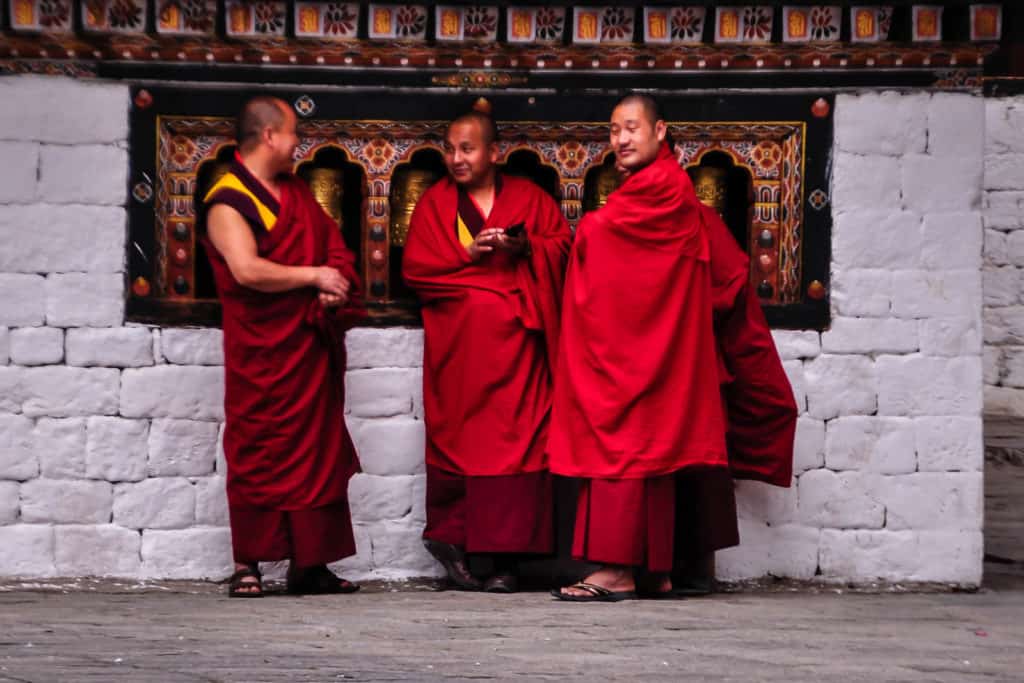
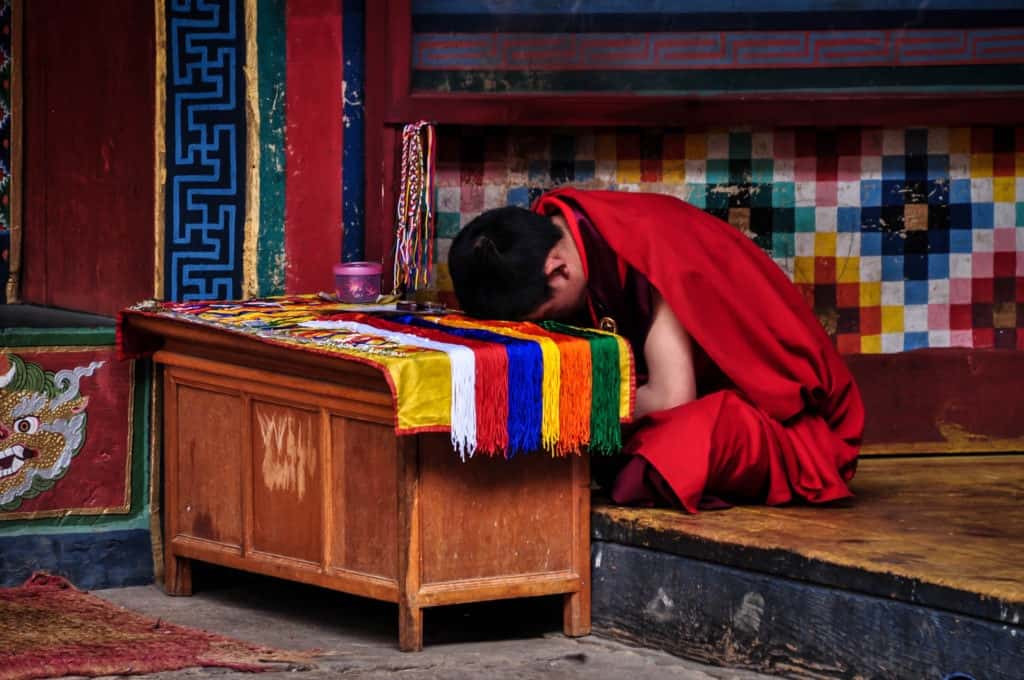
The best of Bhutan: Tiger’s Nest and Punakha Dzong
From Thimphu we left eastbound to Punakha, traversing a national park as road conditions slowly deteriorated and were delayed for a half-hour by logging works. Huge cypresses thundered onto the pavement and were cut up into handy logs by a single lumberjack with a chainsaw. The national park is rigorously protected, and I put rigorously because not only is the unauthorized logging of trees a punishable offense but also picking flowers. I’m all for environmental protection, but after barely two days in this country our Western mindset already struggled with what we perceived as the supremacy of religion and state at the expense of individuality, self-expression, and freedom of choice.
The scenery in this part of Bhutan was comparable to at similar altitudes and the land very sparsely populated. We crossed the Dochula pass above 3000m on our way to Punakha, which at this time of the year is nearly always enshrouded in dense clouds, as it was today. On top of the pass, 108 chortens – small, beautifully adorned temples – sit on a mound and their golden spires sparkled mystically through silvery wafts of mist. It was by far the prettiest war memorial I’ve ever seen (commemorating the fallen Bhutanese soldiers of a battle with Indian rebels).
Before we arrived in the small town of Punakha, we saw the Punakha Dzong. The monastery is beautifully positioned on an island at the confluence of the female river (Mo Chhu) and the male river (Pho Chhu) with lilac-blossoming jacaranda trees surrounding the fort in spring. This dzong, the second largest and oldest, is considered by far the most magnificent in Bhutan and was wonderfully adorned with wood carvings and striking wall murals – so much so, that I looked in vain for a spot that wasn’t lavishly ornamented. The whitewashed walls were erected with pebbles from the rivers and served as a neutral canvas that perfectly underline the ornate and colourful but rather small windows and finely carved, delicate balconies. We’ve visited many temples in our travel so far, in South East Asia, Nepal, and Japan, but none were as exquisite as these pieces of art called dzongs.
From Punakha we returned to Thimphu and drove on to Paro, where we first landed a few days ago at Bhutan’s only international airport. Our first stop in Paro was the National Museum, which was pretty from the outside, especially the round older building, the ta dzong (watchtower), but no longer housed art collections on multiple floors as mentioned in many guide books due to earth quake damage in 2011. At our time of visit only five rooms were open to the public in an annexe that displayed Buddhist masks (I’ve stayed away from wooden masks ever since Morrison, our guide on a tour through Southern Africa, told us that traditional wooden masks are effectively meaningless to African natives but were sold because tourists wanted to buy masks), stuffed animals, and exhibits, which illustrated the Bhutanese way of life.
We dawdled away a half-hour, then crossed the Paro Chhu on a wooden covered bridge and entered the Rinpung Dzong, which was smaller than its counterpart in Punakha but no less captivating. Paro was accustomed to tourists and we strolled along its shopping street lined with souvenir and antique shops. Sante warned us that we should ask for a receipt in case we decided to buy original artefacts that carry an antique seal (a small piece of white cloth with red wax stamp). If you cannot produce the receipt upon departure Druk Air refuses to carry them on board. Bhutan was crawling with dogs, but they seemed well nourished and cared for unlike the lice-ridden, scrawny street dogs we saw in Indonesia.
As dogs may be reborn as humans or vice versa (I hope I’m not), they are not castrated, as that would cause them pain. I have yet to find a guidebook on Bhutan that doesn’t feature the Tiger’s Nest Monastery (also called Paro Taktsang) prominently on the front cover. The monastery’s origins date back to 1692 and the location of this temple complex, snuggled into the sheer rock face at 3120m, is accessible only on foot or muleback, even today. According to legend, Padmasambhaya, the founder of Mahayana Buddhism in Bhutan, chose this site for the foundation of a monastery and flew there on the back of a tigress, hence Tiger’s Nest Monastery.
Sante embellished the legend somewhat I imagine for it reminded me at once of Lord of the Rings. Saddled mules stood patiently under trees close to the trailhead and would carry tourists up to just before the temple complex. I felt sorry for the cute beasts that drew a heavy lot. The trail climbed gently through shady pine forest, but we later learned from another tourist, who was still shocked by the events of that day, that there are different paths to reach the Tiger’s Nest Monastery and some are more exposed than others. A Swedish tourist died when her Bhutanese guide insisted on taking a dangerous shortcut, which she paid for with a fall and a broken neck.
The monastery was almost fully destroyed in a fire in 1998 but beautifully re-erected in its remote, unique location. Huddled against the steep cliff face, it offered spectacular views of the valley as we walked amongst monks dressed in orange robes. Later we sat next to them as they meditated, and the lulling chanting, deep sound of wooden wind instruments, and heavy, sweet scent of incense sticks radiated a sense of calm, though with varying effect. The young monk next to me didn’t stop grinning at us and noisily chewed gum, while in front of us another monk was nodding off and repeatedly bumped his head on a neighbour’s shoulder with his eyes closed. It was reassuring to see a touch of nonchalance at the very core of this deeply religious, solemn community.
The Tiger’s Nest Monastery consists of multiple temples of which we visited five. The rest were either out of bounds to non-Buddhists (fair enough) or to women in general. If I wasn’t already confused by five Buddhas (or seven) and countless reincarnations and needed one more reason to recognise that Buddhism most probably wasn’t for me, I found it in Sante’s explanation of why women are banned from entering certain temples. ‘These temples are out of bounds to women because they are not as mentally stable as men,’ he replied.
We were surprised to see very young monks and learned from Sante that, at the age of five, they decided to spend the rest of their lives a monk. It beats me, how these children, little older than a toddler, wake up one morning and want to be a monk for the rest of their life. If I remember correctly, at the age of 5, I wanted to be a mermaid in Disney’s Arielle cartoon and my biggest wish in life was a talking Baby Born doll (which my parents did not fulfil).
The biggest decision I faced was having a bread roll with poppy seeds or sesame seeds for breakfast and if someone had taken me away from my family with the prospect of a two-week holiday after two years singsonging in a monastery, I would have raised hell. Family visits to the monastery are however allowed. Sante remarked that, surprisingly, a lot of monks in their late teens crave a normal, modern life but because it is forbidden to retire from this lifetime vocation, they abscond and hide with friends not known to the state. After two or three years (hiding with friends) the state eventually forgets about them and they start a new life. So much for freedom of choice in the fascinating (that, it truly is) Kingdom of the Thunder Dragon.
